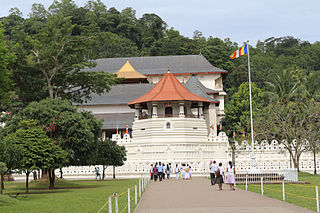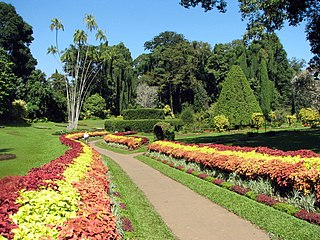
Kandy is a major city in Sri Lanka located in the Central Province. It was the last capital of the ancient kings' era of Sri Lanka. The city is situated in the midst of hills in the Kandy plateau, which crosses an area of tropical plantations, mainly tea. Kandy is both an administrative and religious city and the capital of the Central Province. Kandy is the home of the Temple of the Tooth Relic, one of the most sacred places of worship in the Buddhist world. It was declared a World Heritage Site by UNESCO in 1988. Historically the local Buddhist rulers resisted Portuguese, Dutch, and British colonial expansion and occupation.

Hambantota is the main town in Hambantota District, Southern Province, Sri Lanka.

The toque macaque is a reddish-brown-coloured Old World monkey endemic to Sri Lanka, where it is known as the rilewa or rilawa, . Its name refers to the whorl of hair at the crown of the head, reminiscent of a brimless toque cap.

Gampaha is an urban city in Gampaha District, Western Province, Sri Lanka. It is situated to the north-east of the capital Colombo. It is the sixth largest urban area in Western Province, after Colombo, Negombo, Kalutara, Panadura and Avissawella. Gampaha is also the second largest municipal centre in Gampaha district, after Negombo. Gampaha has a land area of 25.8 ha and is home to the offices of 75 government institutions.

The Mahaweli River, is a 335 km (208 mi) long river, ranking as the longest river in Sri Lanka. It has a drainage basin of 10,448 km2 (4,034 sq mi), the largest in the country, which covers almost one-fifth of the total area of the island. The Mahaweli Ganga starts at Polwathura, a remote village of Nuwara-Eliya District in bank Nawalapitiya of Kandy District by further joining of Hatton Oya and Kotmale Oya. The river reaches the Bay of Bengal on the southwestern side of Trincomalee Bay. The bay includes the first of a number submarine canyons, making Trincomalee one of the finest natural deep-sea harbours in the world.

The primary form of agriculture in Sri Lanka is rice production. Rice is cultivated during Maha and Yala seasons. Tea is cultivated in the central highlands and is a major source of foreign exchange. Vegetables, fruits and oilseed crops are also cultivated in the country. There are two Agriculture Parks abbreviated as A. Parks established by the Department of Agriculture. Out of the total population in Sri Lanka, 27.1% engages in agricultural activities. Agriculture accounted for 7.4% of the GDP in 2020.

Royal Botanic Gardens, Peradeniya are about 5.5 km to the west of the city of Kandy in the Central Province of Sri Lanka. In 2016, the garden was visited by 1.2 million locals and 400,000 foreign visitors. It is near the Mahaweli River. It is renowned for its collection of orchids. The garden includes more than 4000 species of plants, including orchids, spices, medicinal plants and palm trees. Attached to it is the "National Herbarium of Sri Lanka". The total area of the botanical garden is 147 acres (0.59 km2), at 460 meters above sea level, and with a 200-day annual rainfall. It is managed by the Department of national botanic gardens.

Hakgala Botanical Garden is one of the five botanical gardens in Sri Lanka. The other four are Peradeniya Botanical Garden, Henarathgoda Botanical Garden, Mirijjawila Botanical Garden and Seetawaka Botanical Garden. It is the second largest botanical garden in Sri Lanka. The garden is contiguous to Hakgala Strict Nature Reserve.

Ashoka Vatika is a grove in Lanka that is located in the kingdom of the rakshasa king Ravana. It is mentioned in the Vishnu Purana and the Hindu epic Ramayana of Valmiki, and all subsequent versions, including the Ramacharitamanas written by Tulsidas, where it finds mention in the Sundara Kanda. The Vatika has garden houses around it, built by Vishvakarma himself.
The main campus of University of Peradeniya is in Peradeniya, Sri Lanka. It has an additional sub-campus in Mahailuppallama, North Central province. Other than that, several farms and agriculture-related institutions operate off the main campus and the sub-campus.

George Henry Kendrick Thwaites was an English botanist and entomologist.

Henarathgoda Botanical Garden, also known as Gampaha Botanical Garden, is one of the six botanical gardens in Sri Lanka. The botanical garden is situated on the Gampaha-Minuwangoda main road, approximately 450 m (1,480 ft) away from Gampaha railway station. It is about 29 km (18 mi) from Sri Lanka's commercial capital of Colombo.

Seethawaka Botanical Garden, or Seethawaka Wet Zone Botanic Garden is a botanical garden located in Sri Lanka which mainly serves as a research area and a conservation area for threatened and vulnerable endemic plant species in the Sinharaja Rain Forest region. Improving export floriculture, ex situ conservation of wet lowland plants, and bamboo cultivation are also promoted in this garden. The garden was opened to the public in late October 2014 and it is the most recently constructed botanical garden in Sri Lanka.

Idalgashinna Railway Station, Tamil: இடல்கஷின்னா ரயில் நிலையம்) is the 68th station on the Main Line,and fifth highest railway station in Sri Lanka located between Haputale and Ohiya railway stations in Badulla District, Uva Province. It is located 8 km (5.0 mi) west of Haputale, at an elevation of 1,615 metres (5,299 ft) above sea level. The station was built after the track was extended in 1893, from the Nanu Oya railway station to Haputale. This is the 68th railway station on the Colombo-Badulla railway line. The railway station is located on a hilltop separating the southern and eastern parts of Sri Lanka. Because of this the environment is constantly foggy and instantly clear. Depending on the location, rainwater from the Idalgashinna railway station collects in front of the roof to the Mahaweli river valley and water falling from the back of the roof to the Walawe river valley.
Malwattage Celestine Violet Savitri Gunatilleke is professor emeritus at the University of Peradeniya in Sri Lanka's Central Province. She has had a long career in forest ecology and has been a leader in quantitative ecology and education. Most of her research has focused in the Sinharaja rain forest in Sri Lanka. She considers her main contribution to forest ecology to be spreading the idea that successful forest conservation depends on local conservationists. In line with this, she is proud of her students and their accomplishments in the field of conservation.
The Hambantota Refinery is an oil refinery to be developed in Mirijjawila, Hambantota, in the Southern Province of Sri Lanka. The 585-acre (237 ha) refinery will be built and owned by Singapore's Silver Park International (Private) Limited (70%) and Oman's Ministry of Oil and Gas (30%). Silver Park International is an investment vehicle owned by India's Accord Group. It will have a refining capacity of 200,000 barrels (32,000 m3) per stream day, ten times the capacity of the Sapugaskanda Refinery, the country's only other refinery which was built in 1969 by Iran.
Sri Lanka exhibits a remarkable biological diversity and is considered to be the richest country in Asia in terms of species concentration.

Rubber production in Sri Lanka commenced in 1876, with the planting of 1,919 rubber seedlings at the Henarathgoda Botanical Gardens in Gampaha. The total extent under rubber in 1890 was around 50 ha and in the early 1900s it increased to around 10,000 ha. By 1982 the total extent under rubber was around 180,000 ha and the total annual production was 125,000,000 kg (276,000,000 lb). However, the total extent under rubber declined subsequently and at present it is around 120,000 h (430,000 ks)a. Rubber contributes about 0.6% of the total GDP. According to figures published in 2018 by the Rubber Research Institute of Sri Lanka, producing 82,600,000 kg (182,100,000 lb) in 2018.

The tank cascade system is an ancient Sri Lankan irrigation infrastructure. The system is a network of small tanks draining to large reservoirs that store rainwater and surface runoff for later use. Originating in the 1st millennium BCE, the system was designated as a Globally Important Agricultural Heritage System by the United Nations Food and Agriculture Organization in 2017. Centralized bureaucratic management of large-scale systems was implemented from the 3rd to the 13th centuries.


















